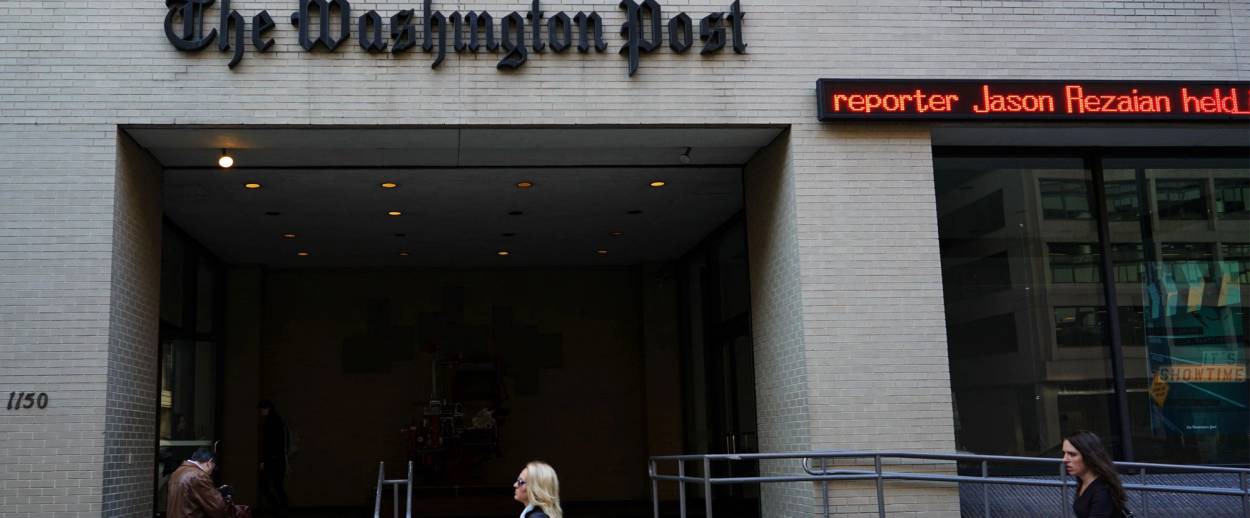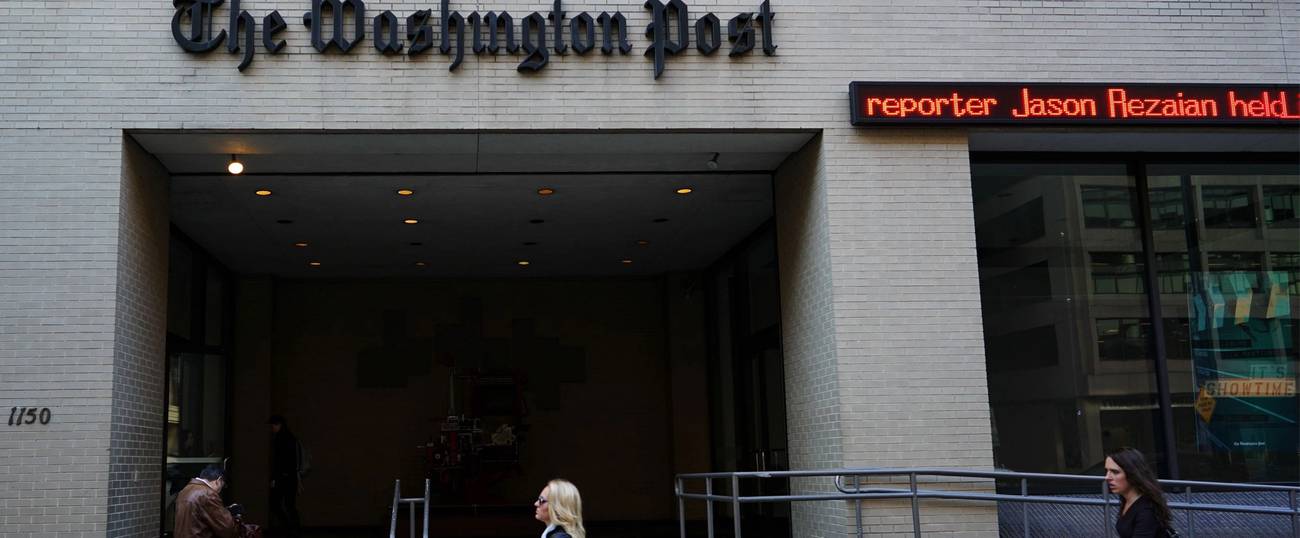The ‘Washington Post’ Pulls Out of Iran, While the ‘New York Times’ Cashes In
Just as reporter Jason Rezaian was freed from two years in captivity, the paper of record was selling luxury tours to Tehran. Why?




Washington Post editor-in-chief Marty Baron says that moving forward, the Iranian government’s treatment of Post correspondent Jason Rezaian—who was imprisoned for nearly two years on trumped-up charges before his release last month—will definitely affect how his paper covers Iran. “Right now we’re not in a position to be able to put a correspondent there,” Baron told the Voice of America. “We’ve had no discussions with the Iranian government about having another correspondent there, and we would need some good assurances from the government that a correspondent there would not be arrested, as Jason was.”
If Baron sticks to his guns, the Post probably won’t have a reporter in Iran for quite a while—proving that, from the Iranian government’s point of view, holding Rezaian hostage was a smart move. By jailing Rezaian, the regime shaped how every Western media organization with a correspondent or even a stringer on the ground covered Iran for two years—or the entire duration of the public debate over the Iran Deal. If you wanted to keep your reporter from being tortured in Evin prison, you’d better not print news that made the Iranian government angry.
Baron also noted that there are factions within the regime itself. In the standard reading, there are moderates, like President Hassan Rouhani, and Foreign Minister Javad Zarif, who oppose hardliners, like the Revolutionary Guard Corps and the office of the supreme leader, Ali Khamenei. In this reading, the hardliners are responsible for every bad thing that Iran ever does—from funding terrorism to detaining American sailors. The hardliners do bad things because they’re bad guys and because they’re competing with the moderates. They tossed an American journalist in jail to show the Rouhani clique who really calls the shots, which is why Western journalists were so sympathetic to the moderates and took their side against the hardliners. Except it wasn’t the hardliners who put Rezaian in jail, it was the moderates—because that’s how they won the hearts and minds and terrified the imaginations of the Western media, which played a key role in buttressing their position.
The Post’s No. 1 rival, the New York Times, did the Post one better: It not only gave the moderates all the great press they wanted, but as Rezaian languished in prison, it set up a travel business to send tourists to the land of his captors. “Travels from Persia” is one of the pricey travel packages put together by “Times Journeys,” which is operated by “the business side of the New York Times Company.” (The Times did not reply to requests for comment.) You can be pretty sure that the regime in Tehran doesn’t recognize the business/journalism distinction, and the paper of record didn’t help matters when it pulled down the firewall with both hands, by having name reporters like Roger Cohen, Elaine Sciolino, and John F. Burns moonlight as tour guides.
In Foreign Policy, my Tablet magazine colleague James Kirchick found it “dismaying that the Times would collaborate in a business venture with a government currently imprisoning an American reporter.” However, that’s apparently why the Times went into business with the regime: to spare their own people the fate of Jason Rezaian, while also ensuring that they would have plenty of access to the regime—or the only people in the regime who speak to Western reporters, namely the moderates. It’s a bribe, like the Joint Comprehensive Plan of Action, which gave Iran over $100 billion plus massive sanctions relief in exchange for promising to hold off for 15 years on building a nuclear bomb.
But there’s a larger purpose with the JCPOA—regional realignment. President Barack Obama thinks American Middle East policy is wrongheaded and dangerous—we side too much with allies, like Israel, Saudi Arabia, and Turkey, which only makes other countries in the region like Iran mad. The Times also has a larger purpose with its travel business—media realignment. If the old, failed media model was about selling information to consumers, the new model was to sell eyeballs to advertisers—except who wants to pay for eyeballs?
The answer, if the Times’ own balance sheet is to be believed, is virtually no one. In this context, Iran isn’t a news story—a worthless, publicly owned commodity, which the Times provides for free to Internet behemoths like Google, Facebook, and Twitter. Instead, it is one of the New York Times Company’s unexploited revenue streams, synergistic luxury travel info-tainment in the kinds of daring, hard to get to destinations that make you the center of conversation at dinner parties in Davos, or Larchmont.
***
Back in the old days, of course, authoritarian regimes were trouble spots for media organizations. Dictators could toss journalists in jail or kill them. Nearly as troubling was getting thrown out of a country and losing access. As former CNN executive Eason Jordan admitted in 2003, the network frequently failed to report on important stories critical of Saddam Hussein’s regime because it wanted to keep its bureau in Baghdad open.
But in the new journalism model being pioneered by the Times, authoritarian regimes are a good thing. You can’t make much money selling access to a free society—anyone can go to, say, Israel, and kick around there for a few days or weeks. But Iran? Only the Times knows Iran. The Times has bought the Iran concession, which—and this is the best part of the deal—it pays for in newsprint, which may be nearly worthless to advertisers, but turned out to be worth $100 billion to the Iranian regime.
Would the regime have struck a deal with the Times if the paper of record promised to send its toughest, hardest-hitting reporters—the kinds of tough guys like Burns or C.J. Chivers who would rather have their fingernails pulled out one by one by the torturers in Evin prison than pull their punches in print? Right now the Times’ man in Iran is the Dutch-born correspondent Thomas Erdbrink, who it seems fair to say has a somewhat milder appetite for discomfort. “I’m no longer allowed to travel to the @nytimes headquarters without a visa. America, it was fun while it lasted,” Thomas Erdbrink tweeted last week. And in another tweet, he explained that “My wife Newsha Tavakolian, @MagnumPhotos, can no longer enter the U.S. with her EU passport: because Iranian born.”
Actually, Erdbrink is wrong: He is complaining about legislation passed in the wake of the San Bernardino terrorist attacks, which put new restrictions on passport holders from 38 mostly European countries who were previously allowed entry into the United States without visas. The purpose of the new law is to prevent terrorists with Western passports from exploiting the visa waiver program. It requires people who have visited Iran, Iraq, Syria, and Sudan since March 2011 to get a visa. In other words, Erdbrink’s wife is welcome to visit the United States—all she has to do is get a visa, like most other people around the world. Erdbrink himself shouldn’t even need a visa since the law has an exception for journalists, unless there’s something odd about his citizenship status.
Weird, right? That a major journalist doesn’t know a significant fact pertaining to his beat, and his personal life. Or maybe he does know, and he’s concerned the new law will take a bite out of the Times’ travel business. In fact, selective ignorance seems to be Erdrbink’s journalistic trademark. For instance, there was the time he blamed sanctions for the pollution in Tehran. “Sanctions do not allow #Iran to import gasoline, is unable to produce cleaner gas itself, so adds much to existing pollution,” he tweeted, before others, including Iranian-born Wall Street Journal reporter Sohrab Ahmari, explained to him that sanctions had nothing to do with the pollution in the Iranian capital.
Then there was the time he wrote, “Is Iran’s Berlin Wall of internet censorship crumbling down? I am tweeting from Tehran from my cell without restrictions.” The way Erdbrink saw it, these new freedoms could only be the work of Iran’s reform-minded president, Hassan Rouhani. However, it was just a glitch: A day after Erdbrink’s paean to the great Rouhani for his social media freedoms, Iran again shut down access to social media.
Still, Rouhani’s a good guy, in Erdbrink’s opinion, and that’s why he goes out of his way to defend the Iranian president. For instance, there was the time Rouhani went on Christiane Amanpour’s show on CNN and condemned the Holocaust. Except the hardliners denied that Rouhani ever referred to the Holocaust. Yes he sure did condemn the Holocaust, wrote Erdbrink—Rouhani’s a moderate not a hardliner. But the hardliners were right, as one of Erdbrink’s sources admits—in that Rouhani never used the word “Holocaust.” Nor did Rouhani ever wish Israelis a Happy Rosh Hashanah, like Erdbrink wrote. As the Times later noted in a correction—another Erdbrink trademark—the clerical regime sent greetings to Jews worldwide, a move whose obvious purpose was to underscore the clerical regime’s contention that it has no problem with Jews whatsoever. It’s just the Zionists they want to wipe off the map.
But the Times’ Tehran bureau chief isn’t supposed to be a journalist—he’s there to manage the company’s Iran account. And the key to being a good account manager is to please the clients, Iran’s moderates, who aren’t afraid to pull out a few fingernails in return for good publicity, and a hundred billion dollars in cash.
***
To read more of Lee Smith’s analysis of Middle East politics for Tablet magazine, click here.
Lee Smith is the author of The Permanent Coup: How Enemies Foreign and Domestic Targeted the American President (2020).